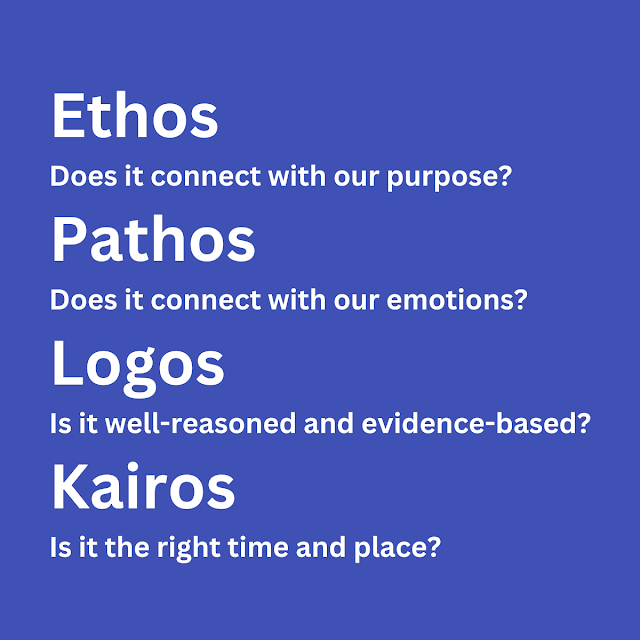 |
| Aristotle (from Wikipedia) |
Understanding and using each in the strategies we develop and execute, and in how we present them to others, is vital to achieving good outcomes.
Logos
Is it well-reasoned?
The first standard that any strategy must meet is that it must be well reasoned from verifiable evidence or clearly stated assumptions.
Likewise, the first challenge we face when communicating strategy is to convey that evidence and logic to our audience.
From all the causes and effects which could or do impact a business, we must pick and convey only the most salient ones.
As strategists, we have numerous models and frameworks to help us to achieve this.
Pathos
Does it connect to our emotions?
Reason alone, however, is often insufficient to motivate people to do something difficult or to change.
For that, as most marketers are well aware, we also need to appeal to people's emotions; to tap into their personal hopes, desires and fears.
For this, we use techniques like story-telling to communicate in a way that resonates on a personal level.
Ethos
Is it good?
Deep down, most people want to believe they are good and do good. Of course, definitions of "good" may vary widely.
A strategy which overtly aligns with, taps into and supports people's sense of goodness is much more likely to be well received and succeed than one which does not.
In Greek philosophy, ethos required that the speaker making a presentation be deemed to be of good and virtuous character.
In modern terms, we talk more often about purpose, trustworthiness, authenticity and credibility. Ethos is often demonstrated through alignment with shared values and transparency in communications.
Ethos applies to the leadership presenting and leading a strategy, as well as to the strategy itself.
Kairos
Is this the right time and place?
The right strategy at the wrong time is as useless as the wrong strategy.
We often talk about a window of opportunity. If our strategy is too far ahead of its time, the market may lack the willingness or infrastructure for it to succeed - we may need to slow it down. If it is too late, other potentially better solutions may already be available.
When presenting our strategy, we must consider our audience's level of knowledge (logos) and likely emotional (pathos and ethos) reaction before we start. Our presentation must guide them (and their beliefs) from where they are to where we need them to be. Rushing in with the solution too soon may cause you to lose your audience and can cause them to raise barriers which will make it even harder to get your message across.
Think of your strategy like a film
In the world of strategy, the interplay of ethos, pathos, logos, and kairos creates a powerful recipe for success. Just like they do for a good film.
A good film will grapple with the battle between good and evil (ethos), is populated by characters we can relate to, root for or against, and imagine how we would react and feel in those circumstances (pathos), has a plot which is internally consistent and makes sense, (logos) provides sufficient context for when and where the film is set, and plays out at a pace which is neither to quick nor to slow (kairos).
If all of those ingredients are present and balanced, we will be drawn into the film experience. If any are missing or weak, the illusion is shattered.
Origins
Ethos, pathos, logos and kairos all appear in Aristotle's Rhetoric.
We would be well advised to leverage these timeless principles to develop and present strategies that resonate, motivate, and drive positive outcomes.


No comments:
Post a Comment